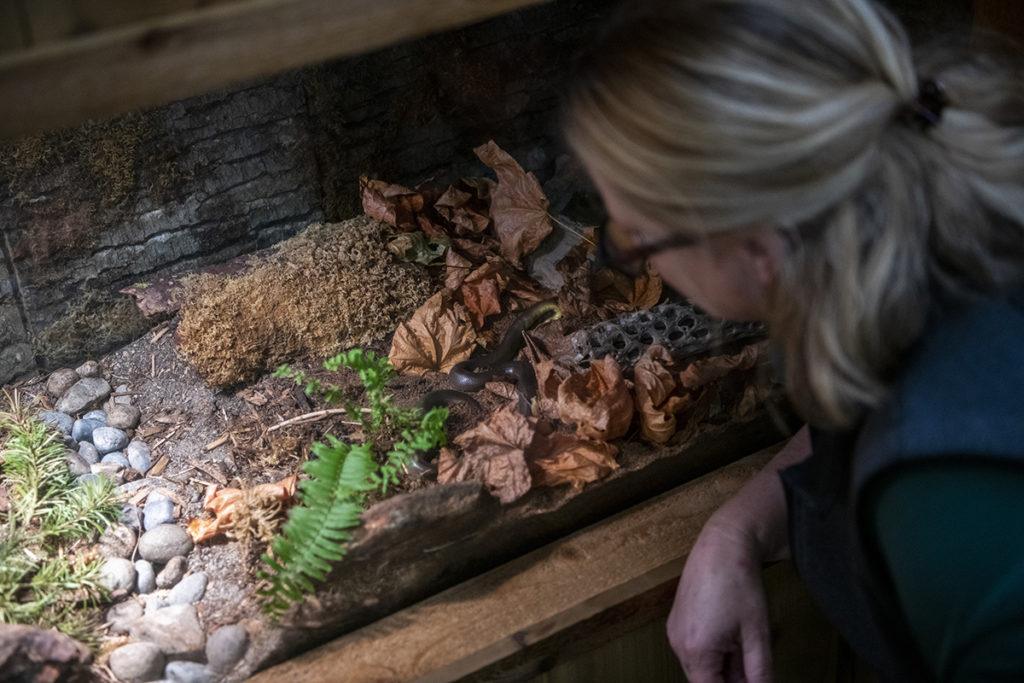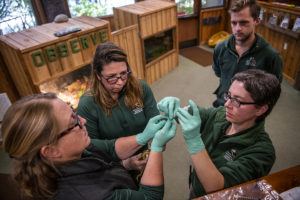
NOTE: Sadly, our rubber boa passed away soon after this story was published. She had received the best of care and will be missed.
Rubber boas usually don’t get a lot of attention. In the wild, this Western American snake stays out of the spotlight, active at night and burrowing during the day. Their smooth, light brown skin blends perfectly with the forest floor.
But at Northwest Trek this month, the rubber boa in the Cheney Discovery Center was the center of some extraordinary care – and affection – from veterinary staff and keepers alike.
“All right, girl,” murmured keeper Wendi Mello, crouching at the back of the rubber boa habitat and gently reaching inside. At her touch, the snake instantly started to curl around her hand – but upside down.
“That’s not a good sign,” noted veterinarian Dr. Allison Case, in a worried tone. “Let’s see what we can do.”
When a snake gets sick
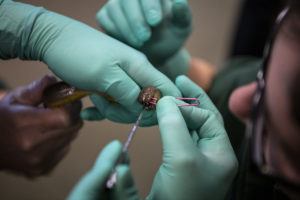
For a few days now, Miss Boa (as she’s affectionately known) has been showing worrying symptoms: dehydration, lack of interest in food and a disconcerting inability to know which way was up. After testing, Case had a couple of theories on what might be wrong, but everyone knew what the boa needed immediately: food and fluids.
“I could tell when I noticed her skin was loose, kind of like if you’re wearing a rash guard shirt that’s too big for you,” explained Mello. “And she wasn’t eating.”
Mello carefully carried the coiling, 20-inch boa across to where Case and veterinary technician Tracy Cramer were waiting. As Case steadied Miss Boa’s head with a gentle thumb and forefinger, Cramer slowly slid a tube down the snake’s esophagus, and squeezed in a combination of anti-inflammatory and antibiotic medication.
Miss Boa curled around even more, trying to burrow into Mello’s cupped hands.
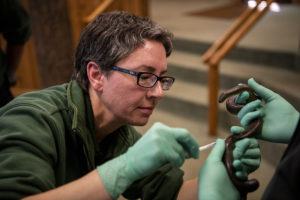
“Oh, baby,” murmured Mello. “It’s okay.”
Together, she and Case gently stretched out the snake, with Mello supporting her fluid brown body and Case stroking the tiny head and talking as a distraction.
“Mmm, this stings, I know,” Case told her reassuringly, as Cramer found the right spot and gave the boa an injection of much-needed fluids, vitamins and electrolytes.
A special reptile
The stakes are high for Miss Boa – because she isn’t an ordinary snake. She was rescued in 2006 by a Trek staff member from someone who had (illegally and inadvisedly) decided to take her out of the wild as a pet.
It was exactly the kind of surprise that Mello – a keeper who delights in animals that aren’t traditionally furry and cute – loved.
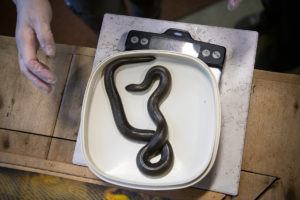
“Rubber boas are so cool,” she says. “Obviously it was terrible that this one had been taken from her home in the wild. But since she had, Northwest Trek was exactly the right place to care for her and give her a good life.”
And Miss Boa has indeed had a very comfortable life, cared for daily and connecting guests to a beautiful species they may never see in the wild. One of just two boa species in Western Washington, they’re known for their docile, even shy manner. Like all snakes, they help keep ecosystems in balance by preying on rodents.
Now she’s around 20 years old, Case estimates, and needs all the support she can get.
“I’m sorry, honey, but I have to do this,” apologizes Case, as she delicately lowers the snake onto a clean surface, deliberately upside down.
Miss Boa instantly rights herself.
“Oh, that’s good!” cheer Cramer, Case and Mello in unison.
Case repeats the test twice more, satisfied that the boa’s orientation has definitely improved. Scooping her up, Mello returns her to the habitat and holds out a bit of warmed-up frozen mouse in a pair of tweezers, waiting patiently. Miss Boa flicks her tongue a couple of times and nudges the food, but then sinks back to burrow under a leaf. Mello – who alternates with other keepers to care daily for all the Cheney Center animals – makes detailed notes on a clipboard.
“Hmmm,” Case says. She and Cramer have read widely on viral infections in snakes, consulting with animal pathologists and colleagues around the zoo world, and researching what has worked in other reptiles.
“This is uncharted territory,” explains Mello.
The trio plan a schedule for two more of the injection treatments, after which Case will reassess. Whatever happens, it’s assured that Miss Boa will get all the care she – and every animal – deserves.
